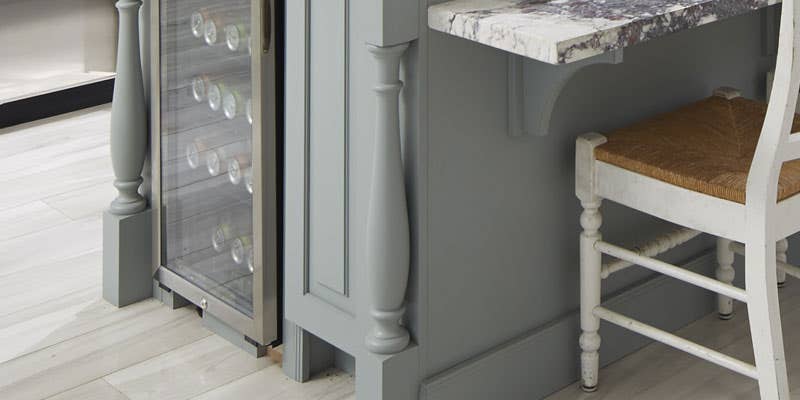Boost Functionality and Design Using High Quality Legs For Kitchen Island
Wiki Article
Important Elements to Consider When Choosing Legs For Kitchen Island
Choosing the appropriate legs for a kitchen area island entails a cautious analysis of multiple aspects that can significantly influence both capability and aesthetic appeal. As we check out these elements, it becomes clear that each decision can have far-ranging implications for the general cooking area experience.Material Options
When selecting legs for a kitchen area island, recognizing the various material choices is essential for achieving both aesthetic charm and architectural integrity (Legs For Kitchen Island). The choice of material substantially affects not just the resilience of the island however additionally its total layout and functionalityMetal legs, typically made from stainless steel or wrought iron, contribute a modern and industrial feel while ensuring toughness and security. These products are immune to use and can sustain considerable weight, making them suitable for bigger islands.
One more option is crafted products, like MDF or plywood, which can be much more affordable while still offering a series of coatings. Nevertheless, they may not provide the very same degree of stability as solid timber or metal. Products such as acrylic or glass can produce a contemporary appearance, though they may call for additional assistance to guarantee security.
Eventually, the selection of product for kitchen island legs must align with the desired performance and the overall motif of the kitchen.
Design And Style

When thinking about style, the shape and finish of the legs are vital. Tapered legs can offer a sense of lightness and elegance, while thicker, more robust legs can convey strength and stability. Furthermore, the coating-- be it repainted, tarnished, or all-natural-- should match the cabinetry and counter top products to produce a unified look.
Moreover, the layout of the legs can likewise mirror personal preference. Customized or decorative legs, such as those featuring complex makings or distinct geometric shapes, can work as centerpieces, including character and personality to the kitchen. Eventually, the right selection will certainly not just improve capability however also elevate the visual allure, making the cooking area island a standout feature of the home.
Height Factors To Consider
Picking the ideal elevation for kitchen area island legs is crucial, as it directly affects both performance and convenience. The basic height for a cooking area island commonly varies from 36 to 42 inches, straightening with common counter top elevations. A 36-inch height is perfect for cooking and food preparation, permitting comfortable use of cooking area devices and devices. Conversely, a height of 42 inches is commonly favored for islands planned for bar seating, accommodating taller feceses and using an informal dining experience.
It is additionally essential to account for users' elevations and choices. Tailoring the elevation can make sure a comfy experience for all household members, making the kitchen area island a more pleasurable and functional room.
Weight Support
Guaranteeing adequate weight assistance for cooking area island legs is crucial for both security and functionality. The cooking area island commonly serves multiple objectives, consisting of cooking, dining, and added storage space, necessitating a robust assistance framework. When picking legs, it is vital to take into consideration the general weight capacity called for based on the island's planned use and the materials that will certainly be positioned on it.The selection of material for the legs plays a substantial duty in their weight-bearing abilities. Strong wood, metal, and navigate to these guys durable compounds normally check this site out offer remarkable strength contrasted to lighter products. In addition, the style of the legs-- whether they are straight, tapered, or have a pedestal type-- can affect their ability to distribute weight effectively throughout the structure.
Constantly speak with the supplier's specifications regarding load restrictions to ensure that the legs can sustain the designated weight without compromising safety. In recap, picking kitchen area island legs with adequate weight assistance is necessary for developing a functional and secure culinary space.
Installation and Maintenance
Proper installation and upkeep of kitchen area island legs are vital for making certain longevity and stability. To start, it is vital to follow the maker's standards during installment. This frequently entails safeguarding the legs to the island base using appropriate fasteners, ensuring that the legs are degree and aligned. Making use of a level device can assist avoid tottering and improve the total visual allure of the cooking area island.As soon as mounted, regular maintenance is required to preserve the integrity and appearance of the legs - Legs For Kitchen Island. For wood legs, periodic cleansing with a damp towel and application of suitable wood gloss can prevent wetness damages and preserve their coating. Metal legs might need a mild cleaning solution to remove grease and gunk, followed by a completely dry towel have a peek at this website to avoid rust formation
Additionally, check the legs consistently for indicators of wear or damages, such as fractures or loosened joints. Tightening up screws or screws as needed can additionally prolong the life-span of the legs. By adhering to these setup and upkeep methods, property owners can ensure that their kitchen area island stays durable and visually appealing for several years to come.
Final Thought

Visual comprehensibility is extremely important in selecting the style and style of legs for a kitchen island, as these elements significantly influence the overall atmosphere of the space. Tapered legs can supply a sense of lightness and beauty, while thicker, extra robust legs can communicate toughness and security.Picking the proper elevation for cooking area island legs is critical, as it straight affects both capability and convenience. In recap, selecting kitchen area island legs with adequate weight support is essential for producing a safe and useful cooking area.
In final thought, choosing legs for a cooking area island demands careful factor to consider of numerous aspects, consisting of product options, style, elevation, weight assistance, and setup.
Report this wiki page